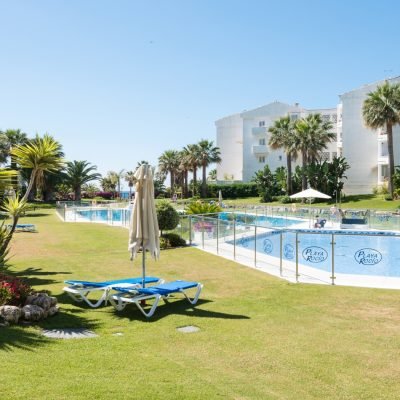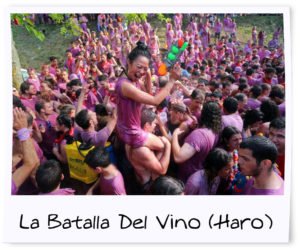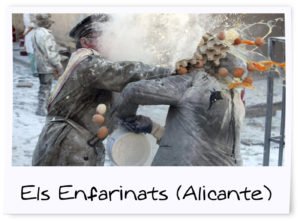My Marbella Weekender: 10 Spanish Festivals You Didn’t Know Existed!
- October 9, 2017
YOU'RE READING
My Marbella Weekender: 10 Spanish Festivals You Didn’t Know Existed!
Spain is undoubtedly one of the most popular holiday destinations in Europe and with its white sandy beaches and laid back atmosphere what’s not to love?!
However sometimes for thrill seekers among us a relaxing beach holiday just doesn’t cut it.
So for those of you looking for a little bit more from your vacay this blog post is for you.
From the wacky, wonderful and just down right weird we have put together a list of our 10 favorite traditional Spanish festivals that we would LOVE to get involved in.
So you’re looking for something a little bit more loco than low key these festivals are definitely worth a visit!
Las Fallas is a traditional Spanish festival held in commemoration of Saint Joseph, the cities patron saint.
Las Fallas translates to ‘The Fires’ and the festival is a one of a kind pyrotechnic display which literally sets the city of Valencia ablaze!
The cities fiery festival sees a population of around one million people swell to an estimated three million during the festivities.
The main concept of the festival is the creation and destruction of ‘fallas’ which are large cardboard and paper mache monuments laden with puppets or ‘ninots’ which are then filled with fireworks and pyrotechnics.
Each Valencian neighborhood creates its own Falla for the procession and these are then scattered around the city for the public to view.
These ‘fallas’ can stretch to up to 30 meters in height and their ultimate purpose after 365 days of being carefully put together, is to be burned to the ground on the final night of the festival aptly named ‘La Crema’ or the burning.
The incineration of the Fallas however is not the only cause for celebration.
The city of Valencia comes alive with brass bands each morning of the 5 day festival to awaken the residents ready for the day’s festivities.
A procession usually follows behind the band with firecrackers to ensure that none of the residents miss out on La Desperta (the wake up call).
Firework displays (Mascleta) are set off each afternoon during the 5 days of The Fallas with many of the cities residents creating their own firework displays.
On the final evening of The Fallas (La Nit Del Foc) around midnight the Fallas are all set alight and each year one ninot is spared (as a result of a public vote) and is displayed at the local Fallas museum!
When are Las Fallas?
15th – 19th March
Where are Las Fallas?
Valencia
La Batalla Del Vino or ‘The Wine Fight’ falls on the 29th June every year.
The battle is of epic proportions, turning most of the vineyard and its surrounding hillsides purple.
The wine festival commences at 7am on the morning of the 29th June with a procession of locals and tourists donning white shirts and red scarves and carrying containers, buckets, jugs and water pistols filled with red wine.
The procession ends up at the cliffs of Bilibio where mass is celebrated.
Following mass the wine throwing battle commences leaving thousands of its participants drenched head to toe in the regions famous rioja!
After the battle ends the sea of purple people decent back into the cobbled streets of Haro and party in the street until the early hours.\
When is La Batalla Del Vino?
29th June
Where is La Batalla Del Vino?
Haro, La Rioja
Over 1 million people flock to the Spanish city of Pamplona every year to witness the ‘Encierro’ or the ‘running of the bulls.’
The main concept of the festival is that between the dates of 7th – 14th July every year at 8am six fighting bulls are let out into the narrow streets of Pamplona to run an 875 metre course which ends up at the cities bullring.
While most do not go to take part in the running there are still over 2000 competitors each year!
Participation in the event is completely free for any person aged 18 or over.
There have been fatalities and each year there are lots of injured runners so taking part is certainly not for the light hearted!
If you don’t fancy risking your life/being impaled on an angry bulls horns then there are many balconies in the city to watch the event from.
While this is a traditional Spanish festival and one of the most famous bull runs in the world, each year it causes protests from animal rights activists due to the cruelty of the bull fighting that takes place during the festival of San Fermin.
When is the Fiesta De San Fermin?
7th – 14th July
Where is the Fiesta de San Fermin?
Pamplona.
Think 1996 Crash Bandicoot trying to escape a massive rolling boulder and you have the Boloencierro!
A more animal friendly version of the Encierro the Boloencierro is a festival created by the town of Mataelpino, just North of Madrid.
During the festival a 10ft wide 440 Pound polystyrene ball is released into the towns streets much like the bulls are in the Encierro.
While the festival is deemed to be a lot safer than the running of the bulls there are still accidents and injuries with people being literally bowled over!
This festival is seen to be a more light hearted and family friendly version of the Encierro, its a fun spectacle to watch for people that are opposed to the use of the bulls.
Since the start of the Boloencierro a number of other Spanish towns have ditched the traditional bull run in favor of the ball run, with the animal activist charity PETA offering to fund a Boloencierro for any town that agrees to stop the use of the bulls.
When is the Boloencierro?
Third week of August
Where is the Boloencierro?
Mataelpino.
St Jordi’s day is Barcelona’s alternative to St Valentine’s day making it the cities most romantic day of the year!
On this day according to tradition couples exchange gifts to show their love for one another. A book is given to the men and a single red rose to the women.
While the tradition of of rose giving stems back to 303 AD, the presenting of the book in return came about in 1923.
This tradition was created in honor of William Shakespeare who died on the same day as the Sant Jordi’s day celebrations take place.
The presenting of the book was the inspiration behind the creation of ‘World Book Day’ which is also celebrated on the 23rd April.
On this day Barcelona’s famous Las Ramblas is filled with hundreds of stalls with over 20 million euros worth of books and about 6 million roses sold each year!
Be sure to check out each stall as some donate part of their profits to charity. – LOVE!
When is Dia De Sant Jordi / El Dia de los Amantes?
23rd April
Where is Dia De Sant Jordi / El Dia de los Amantes?
Barcelona
Known to the locals as El Colacho and to the rest of the world as ‘The Baby Jumping Festival’ this ritual takes place each year in the Spanish village of Castrillo de Murcia.
The festival is the village’s version of a baptism and dates back as far at the 17th century! El Colacho involves parents laying their newborn babies on pillows in the middle of the village streets. A large crowd gathers around and men dressed as devils jump over the little ones to cleanse them of any evil, giving them protection from illness and misfortune.
After ‘El Salto del Colacho’ or ‘The Flight of the Devil’ the babies are then covered in rose petals and are swiftly reclaimed by their parents.
Before the festival begins the Colachos run through the village terrorising the festival goers with a horse tail whip, who in return launch insults at the devil as a warm up to the baby jumping festivities.
While the baby jumping is frowned upon by the Catholic Church who distance themselves from the festival it seems as if the village of Castrillo De murcia is not going to give up its tradition any time soon!
When is El Colacho?
June
Where is El Colacho?
Castrillo de Murcia
Every year on December 28th in the town of Ibi in Alicante takes part in a traditional mock battle that dates back over 200 years commemorating the story of King Herod and the Massacre of the Innocents.
The annual battle involves 2 groups ‘Els Enfarinats’ and ‘La Oposicio.” Els Enfarinats are a group of married men that take charge of the town for one day only, creating ridiculous laws with La Oposicio trying to reinforce the peace.
If the townspeople break the laws set by Els Enfarinats they will be fined, with the money generated from the fines going to charity after the event has finished.
The battle, which has been deemed one of the worlds greatest food fights, then commences with participants donning military style clothing and waging war on each other with eggs, flour and firecrackers for ammunition.
At 5pm the authority of Els Enfarinats comes to an end and the town restores order, albeit a little dirtier!
When is Els Enfarinats?
December 28th
Where is Enfarinats?
Ibi, Alicante
San Juan festival is celebrated on the shortest night of the year to officially welcome in the summer season. It is a night that is celebrated in cities and towns all along the coast of Spain with many people taking to the beaches with their families and friends.
Groups gather together to create bonfires and BBQs with the (slightly dangerous) tradition being to jump over your bonfire three times on the evening of San Juan to cleanse and purify your soul and burn all of your problems away.
Another less life threatening ritual common during this festival is walking backwards into the sea at 12 o’clock to wash away evil spirits, with many locals following the old age tradition of washing your face and feet three times before you leave the water. Upon completing this ritual it is said that you are granted 3 wishes!
This festival is celebrated all over spain, with the local residents taking advantage of the one day of the year where making BBQs and bonfires on the beach is accepted by the town hall.
When is San Juan?
23rd June
Where is San Juan?
This festival is celebrated all over Spain.
As if Spain doesn’t already have enough festivals that involve throwing random things at each other, our final celebration involves throwing paint and oil. The Cascamorras is a festival celebrated between the 2 towns of Guadix and Baza and it takes place on September 6th – 9th every year.
The festival dates back to the middle ages and involves the 2 towns waging war over the possession of a statue of the Virgen de la Piedad. The “Cascamorras” is a clown type figure who travels from Guadix to Baza on this date every year to attempt to steal the statue.
The residents of Baza, in an attempt to stop their statue being stolen, throw paint and oil over the Cascamorras.
Tradition states that if the Cascamorras can make away with the statue of the Virgin de la Piedad without getting stained with paint or tar, then the town of Guadix get to keep the statue.
This however has never happened in the history of the festival and the cascamorras makes his way back to Guadix having failed in his task, where the residents then proceed to plaster him in more paint and oil!
When is Cascamorras?
Between 6th – 9th of September
Where is Cascamorras?
Guadix and Baza (Province of Granada)
So there you have 10 of the most wild and wacky festivals Spain has to offer!
If you would like any more information on any of the festivals mentioned in this blog post be sure to contact My Marbella Weekender at info@mymarbellaweekender.com.
www.mymarbellaweekender.com























1 thought on “My Marbella Weekender: 10 Spanish Festivals You Didn’t Know Existed!”
Love this, thank you for all of the great information.
really interesting!